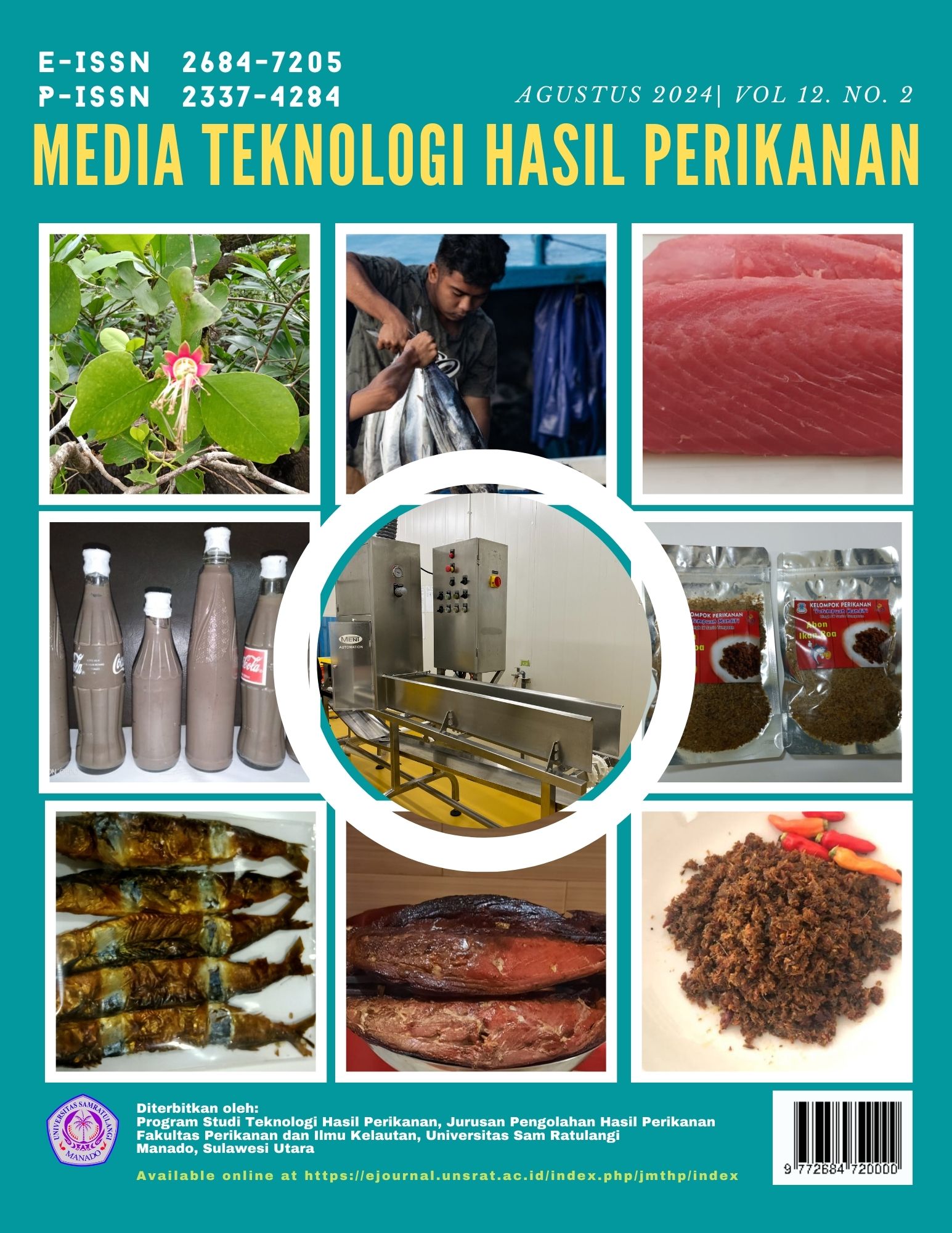Effect of Addition of Kappaphycus alvarezii on Physicochemical Characteristics and Consumer Acceptance of Fishballs Clarias sp.
DOI:
https://doi.org/10.35800/mthp.12.2.2024.43188Keywords:
Fish balls, Kappaphycus alvarezii, physicochemical characteristics, consumer acceptanceAbstract
Fish balls containing high protein but low in fiber need to be diversified to increase the nutritional value while reducing the cost of raw materials. Kappaphycus alvarezii seaweed is rich in fiber and the price is relatively cheaper, so it has the potential to be used as raw material for making fish balls. This study aims to determine the physicochemical characteristics and consumer acceptance of catfish meatballs (Clarias sp.) with the addition of K. alvarezii seaweed. The study used a completely randomized design with four treatments, namely the percentage of seaweed substitution for fish meat (w/w) namely 40%, 50%, 60% and 0% (control) with three replications. Parameters observed were proximate composition, whiteness degree, and hedonic test. The addition of seaweed increased the water content, ash, carbohydrates and whiteness value of fish balls but decreased the protein and fat content. Consumers still prefer the formulation of fish balls without the addition of K. alvarezii seaweed, but that is close to consumer preferences with the addition of 40% seaweed.
References
[BSN] Badan Standardisasi Nasional. 2011. Petunjuk Pengujian Organoleptic dan atau Sensori Pada Produk. Perikanan. SNI 2346:2011. Jakarta: Badan Standardisasi Nasional.
[BSN] Badan Standardisasi Nasional. 2006. Cara Uji Kimia-Bagian 4: Penentuan Kadar Kadar Protein dengan Metode Total Nitrogen pada Produk Perikanan: SNI 01-2354.4-2006. Jakarta: Badan Standardisasi Nasional.
[BSN] Badan Standardisasi Nasional. 2006. Cara Uji Kimia-Bagian 3: Penentuan Kadar Lemak Total pada Produk Perikanan: SNI 01-2354.3-2006. Jakarta: Badan Standardisasi Nasional.
[BSN] Badan Standardisasi Nasional. 2006. Cara Uji Kimia-Bagian 2: Penentuan Kadar Air pada Produk Perikanan: SNI 01-2354.2-2006. Jakarta: Badan Standardisasi Nasional.
[BSN] Badan Standardisasi Nasional. 2006. Cara Uji Kimia-Bagian 1: Penentuan Kadar Abu pada Produk Perikanan: SNI 01-2354.1-2006. Jakarta: Badan Standardisasi Nasional.
Dewi, I. A. Imam S. 2007. Aplikasi Metode AHP (Analytical Hierarchy Process) dalam Menganalisis Faktor-Faktor yang Mempengaruhi Mutu Bakso Ikan Kemasan. Jurnal Teknologi Pertanian. 8(1): 19–25.
Hartati, Junarson, Israndi Aditia. 2011. Pengaruh Rumput Laut Eucheuma Cottonii Sebagai Bahan Pengenyal Alami terhadap Kualitas Bakso Daging Sapi. Surabaya: Berita Litbang Industri.
Istini, S., Zatnika, A., & Suhaimi, A. J. 2002. Manfaat dan pengolahan rumput laut. Jurnal Penelitian BPPT. Jakarta
Lekahena, V. N. J. (2015). Pengaruh subtitusi daging ikan madidihang dengan rumput laut Kappaphycus alvarezii terhadap komposisi gizi bakso ikan madidihang. Agrikan: Jurnal Agribisnis Perikanan, 8(2), 92. https://doi.org/10.29239/j.agrikan.8.2.92-98
Kaemba, A., Suryanto, E., dan Mamuaja, C. 2017. Aktivitas antioksidan beras analog dari sagu baruk (Arenga microcarpha) dan ubi jalar ungu (Ipomea batatas L. poiret). Chemistry Progress, 10 (2).
Mangunang, Yusi Pratiwi. 2019. Penerapan Active Edible Coating Berbasis Kitosan Pada Bakso Ikan Lele Dengan Penambahan Rumput Laut (Eucheuma Cottoni) Dan Karagenan. Skripsi. Lampung: Universitas Lampung.
Masita, I.H. dan Sukesih. 2015. Pengaruh Penambahan Rumput laut terhadap Kekerasan Nugget Ikan Gabus. Jurnal Sains dan Seni ITS. (4:1). 2337-3520
Permana, C. 2013. Pengaruh Penambahan Bubur Rumput Laut (Eucheuma cottonii) Terhadap Sifat Fisik Dan Askeptabilitas Bakso Ayam. Students e-Journal. 2 (3).
Puspitasari, D. 2008. Kajian Substitusi Tapioka Dengan Rumput Laut (Eucheuma Cottoni) Pada Pembuatan Bakso. [Skripsi]. Surakarta (ID): Universitas Sebelas Maret
Putra, D. A. P., Agustini, T. W., & Wijayanti, I. 2015. Pengaruh penambahan karagenan sebagai stabilizer terhadap karakteristik otak-otak ikan kurisi (Nemipterus nematophorus). Jurnal Pengolahan dan Bioteknologi Hasil Perikanan, 4 (2), 1-10.
Rahmawati, D.S., I, Zuraida, R. Hasanah. 2014. Pemanfaatan Rumput Laut (Eucheuma cottoni) Pada Pengolahan Bakso Ikan. Jurnal Ilmu Perikanan Tropis. 2 (2): 33-42.
Ririsanti NN, Evi L, Yudi NI, Rusky IP. 2017. Penambahan Karagenan Terhadap Tingkat Kesukaan Pempek Lele. Jurnal Perikanan dan Kelautan 18(1):165-173.
Santoso J, Yumiko Y, Takeshi S. 2004. Mineral, fatty acid and dietary fiber compositions in several Indonesian seaweeds. Jurnal Ilmu-ilmu Perairan dan Perikanan Indonesia. 11: 45-51
Suprapti M. Lies. 2010. Teknologi Tepat Guna Pembuatan Bakso Daging dan Ikan. Yogyakarta: Kanisius
Nielsen, S. S. (2017). Food Analysis Laboratory Manual. In Food Analysis Laboratory Manual. Springer International Publishing.
Tamrin, Sadimantara MS. 2014. Kadar Karaginan Terhadap Karasteristik Kimia Pasta Mete. Jurnal Agriplus 2(24): 21-28.
Widodo, Setyo A. 2008. Karakteristik Sosis Ikan Kurisi (Nemipiterus nematophorus) dengan Penambahan Isolat Protein Kedelai dan Karagenan pada Penyimpanan Suhu Chiiling dan Freezing. Skripsi. Fakultas Perikanan dan Ilmu Kelautan. IPB
Winarno, F.G. 2008. Kimia Pangan dan Gizi. JakartaGramedia Pustaka Utama.
Downloads
Published
How to Cite
Issue
Section
License
Copyright (c) 2024 Renzy Sali, Andi Mismawati, Ita Zuraida, Seftylia Diachanty, Bagus Fajar Pamungkas

This work is licensed under a Creative Commons Attribution-ShareAlike 4.0 International License.
Authors who publish with this journal agree to the following terms:
- Authors retain copyright and grant the journal right of first publication with the work simultaneously licensed under a Creative Commons Attribution License that allows others to share the work with an acknowledgement of the work's authorship and initial publication in this journal.
- Authors are able to enter into separate, additional contractual arrangements for the non-exclusive distribution of the journal's published version of the work (e.g., post it to an institutional repository or publish it in a book), with an acknowledgement of its initial publication in this journal.
- Authors are permitted and encouraged to post their work online (e.g., in institutional repositories or on their website) prior to and during the submission process, as it can lead to productive exchanges, as well as earlier and greater citation of published work (See The Effect of Open Access).







